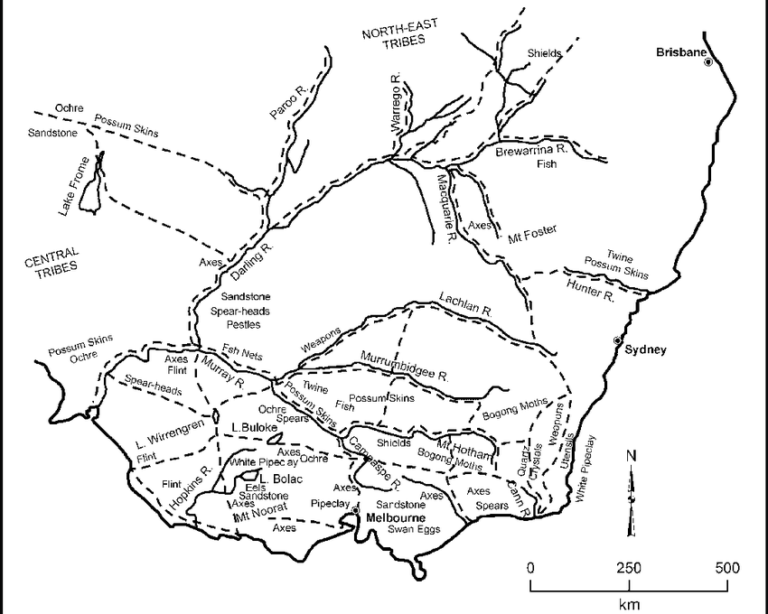Australia’s vast landscapes are not only a testament to its natural beauty but also to its rich cultural heritage. One intriguing aspect of this heritage is the overlap between Australian stock routes and the traditional pathways of Indigenous communities. These ancient tracks serve as a bridge between the past and the present, revealing a profound connection between the land and its people.
The Historical Tapestry
The stock routes in Australia have a storied history that transcends time. They were more than just paths for droving livestock; they were the lifeblood of trade, ceremony, and kinship among Indigenous communities (Behrendt & Thompson, 2003). These routes have deep ties to the cultural landscapes of Indigenous people, as they often follow watercourses and pathways that have been used for generations (Lennon, 2014).

Aboriginal Traditional Pathways
Before European contact, Australia was crisscrossed by networks of Aboriginal travel lines, connecting vital food and water sources. These trails had multifaceted purposes, serving as routes for travel, ceremonies, and trade, while also featuring traditional camping places along the way (Spooner, Firman & Yalmambirra, 2010). River-based routes were likely established as traditional Aboriginal tracks, and it is probable that early routes across arid regions, connecting isolated water sources were influenced by Aboriginal knowledge, like Aboriginal wells, waterholes and artesian springs (Pearson, 1999).
The Evolution of Stock Routes & Cultural Significance
Many stock routes were developed from Aboriginal travel lines and trading pathways, because they followed the most accessible routes through the landscape, avoiding natural obstacles, and linking water sources (Spooner, Firman & Yalmambirra, 2010). The transfer of knowledge from Aboriginal guides, trackers and workers played a crucial role in shaping these routes. Modern Stock routes often intersect with Indigenous trading paths, Song Lines, and Dreaming Tracks (Department of Environment and Climate Change NSW 2008). Consequently, they contain numerous sites and objects of significance to Aboriginal people, including scarred or carved trees, camp sites, ceremonial grounds, and rock shelters (Nowland et al. 1997). Recognizing the importance of this cultural heritage, Aboriginal traditional owners and Local Aboriginal Land Councils are among the key stakeholders of Australian Stock Routes (Smiles, Merchant & Profit, 2011).

A Living Heritage
The TSR (Travelling Stock Routes) network provides important connections for many Aboriginal Australians to their traditional travel lines. Fortunately, TSRs have remained publicly accessible, rather than restricted by land tenure like other areas and continue to provide resources used by many Aboriginal communities (Guilfoyle, 2006). They have ongoing social importance, by supporting recreational activities and community groups (Smiles, Merchant & Profit, 2011). Exploring these the stock routes, which are derived from these intersecting paths, is like embarking on a journey that transcends time. It allows us to meet the custodians of culture, understand the interplay between traditional land use and modern conservation, and celebrate the spirit of Indigenous communities whose connection to these routes echoes through the whispers of the wind.

The Australian stock routes and Aboriginal traditional pathways unveil a captivating story of heritage and connection. These routes, which served as vital lifelines for Indigenous communities, now serve as a bridge between the past and present, highlighting the importance of preserving and celebrating this unique cultural tapestry. By honoring the stock routes and the traditional pathways they originate from, we not only pay tribute to Australia’s rich history but also acknowledge the enduring spirit of its Indigenous people.
References:
Behrendt, J & Thompson, P & Healthy Rivers Commission of New South Wales. (2003). The recognition and protection of Aboriginal interests in NSW rivers / by Jason Behrendt and Peter Thompson. Sydney : Healthy Rivers Commission of New South Wales. [Link: http://www.hrc.nsw.gov.au/site/pdf/OCP/OCP8.pdf]
Department of Environment and Climate Change NSW (2008) Towards an aboriginal land management framework for NSW. Discussion paper. Department of Environment and Climate. Change NSW, Sydney.
Guilfoyle D. (2006) Aboriginal cultural heritage regional studies: an illustrative approach Department of Environment and Conservation NSW, Sydney.
Lennon, J. (2014). ‘The long paddock,’ Australia’s travelling stock route network – a distinctive cultural heritage. The Historic Environment, 26, 46. [Link: https://www.academia.edu/74106207/The_long_paddock_Australias_travelling_stock_route_network_a_distinctive_cultural_heritage]
Morse, D. (2021, April 30th). Research into Ancient Aboriginal Migration across Australia. ABC News. [Link: https://www.abc.net.au/news/2021-04-30/research-into-ancient-aboriginal-migration-across-australia/100105902]
Nowland A., Murray-Darling Basin Commission, Total Catchment Management NSW, and Rural Lands Protection Boards’ Association of NSW (1997) Sustainable management strategy for travelling stock routes and reserves in Central Western New South Wales. Rural Lands Protection.
Pearson, M. (1999). Paroo Tracks: Water and Stock Routes in Arid Australia. [Link: https://www.aicomos.com/wp-content/uploads/Paroo-tracks-water-and-stock-routes-in-arid-Australia.pdf]
Smiles, B., Merchant, C., & Proft, K. (2011). The NSW travelling stock routes and reserves network. National Parks Association of NSW. [Link: https://assets.nationbuilder.com/natureorg/legacy_url/2757/6-the-tsr-network-heritage-habitat-and-livelihood-2011.pdf?1630462729]
Spooner, P & Firman, M & Yalmambirra,. (2010). Origins of Travelling Stock Routes. Connections to Indigenous traditional pathways. 32. 329-339. 10.1071/RJ10009. [Link: https://www.researchgate.net/figure/A-map-of-south-eastern-Australia-showing-the-location-of-important-Indigenous-trading_fig1_278913300]

